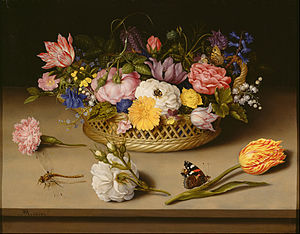Ambrosius Bosschaert
Ambrosius Bosschaert | |
|---|---|
 Still-Life of Flowers, 1614, J. Paul Getty Museum, Los Angeles. | |
| Born | 18 January 1573 |
| Died | 1621 (aged 47–48) |
| Nationality | Dutch and Flemish |
| Known for | Painting |
| Movement | Baroque |
Ambrosius Bosschaert the Elder (18 January 1573 – 1621) was a Flemish-born Dutch still life painter and art dealer.[1] He is recognised as one of the earliest painters who created floral still lifes as an independent genre.[2] He founded a dynasty of painters who continued his style of floral and fruit painting and turned Middelburg into the leading centre for flower painting in the Dutch Republic.[2][3]
Biography[edit]

He was born in Antwerp, where he started his career, but he spent most of it in Middelburg (1587–1613), where he moved with his family because of the threat of religious persecution. He specialized in painting still lifes with flowers, which he signed with the monogram AB (the B in the A).[1] At the age of twenty-one, he joined the city's Guild of Saint Luke and later became dean.[1] Not long after, Bosschaert married and established himself as a leading figure in the fashionable floral painting genre.
He had three sons who all became flower painters: Ambrosius II, Johannes and Abraham. His brother-in-law Balthasar van der Ast also lived and worked in his workshop and accompanied him on his travels. Bosschaert later worked in Amsterdam (1614), Bergen op Zoom (1615–1616), Utrecht (1616–1619), and Breda (1619).[1] In 1619 when he moved to Utrecht, his brother-in-law van der Ast entered the Utrecht Guild of St. Luke, where the renowned painter Abraham Bloemaert had just become dean. The painter Roelandt Savery (1576–1639) entered the St. Luke's guild in Utrecht at about the same time. Savery had considerable influence on the Bosschaert dynasty.[1]
After Bosschaert died in The Hague while on commission there for a flower piece, Balthasar van der Ast took over his workshop and pupils in Middelburg.[1]
Style[edit]

His bouquets were painted symmetrically and with scientific accuracy in small dimensions and normally on copper. They sometimes included symbolic and religious meanings. At the time of his death, Bosschaert was working on an important commission in the Hague.[1] That piece is now in the collection in Stockholm.[1][4]
Bosschaert was one of the first artists to specialize in flower still life painting as a stand-alone subject. He started a tradition of painting detailed flower bouquets, which typically included tulips and roses, and inspired the genre of Dutch flower painting. Thanks to the booming seventeenth-century Dutch art market, he became highly successful, as the inscription on one of his paintings attests.[5] His works commanded high prices although he never achieved the level of prestige of Jan Brueghel the Elder, the Antwerp master who contributed to the floral genre.[3]
Legacy[edit]
His sons and his pupil and brother-in-law, Balthasar van der Ast, were among those to uphold the Bosschaert dynasty which continued until the mid-17th century.
It may not be a coincidence that this trend coincided with a national obsession with exotic flowers which made flower portraits highly sought after.
Although he was highly in demand, he did not create many pieces because he was also employed as an art dealer.
References[edit]
- ^ a b c d e f g h Ambrosius Bosschaert at The Netherlands Institute for Art History
- ^ a b Irene Haberland, Bosschaert family at Oxford Art Online
- ^ a b "Chinese Vase with Flowers, Shell and Insects". Museo Nacional Thyssen-Bornemisza. Retrieved 7 June 2020.
- ^ Link to Stockholm piece in the RKD
- ^ Bouquet of Flowers in a Glass Vase, the painting with inscription Archived 10 October 2012 at the Wayback Machine at the National Gallery
Bibliography[edit]
- Pennisi, Meghan Siobhan Wilson (2007). The flower still -life painting of Ambrosius Bosschaert the Elder in Middelburg, ca. 1600–1620 (PhD thesis). Evanston, Illinois: Department of Art History, Northwestern University.
- Wheelock, Arthur K. (24 April 2014). "Bosschaert, Ambrosius Dutch, 1573–1621" (PDF). Collection: Artists. National Gallery of Art. Archived (PDF) from the original on 9 October 2022. Retrieved 12 November 2017.
- "Bosschaert de Oudere, Ambrosius". Winkler Prins encyclopedia (8 ed.). 1975.
- Stechow, Wolfgang (1966). "Ambrosius Bosschaert: Still Life". The Bulletin of the Cleveland Museum of Art. 53 (3): 61–65. JSTOR 25152092.
External links[edit]
 Media related to Ambrosius Bosschaert (I) at Wikimedia Commons
Media related to Ambrosius Bosschaert (I) at Wikimedia Commons
